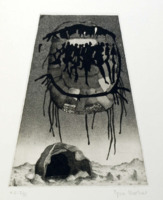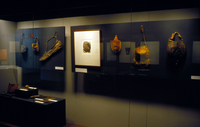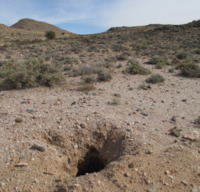Items
Site
The Medicine Chest
keywords is exactly
landscape
-

Etching from 'Sound from the Thinking Strings'
"Skotnes’s own visual interpretation of the history and cosmology of the |xam formed the last component of this interdisciplinary endeavour and constituted a visual component that drew together the various strands of disciplinary interpretations and presented a perspective on the |xam life she felt ‘was missing from the other interpretations’ (Skotnes 1991: 30). In these images she drew freely on San mythology, accounts of |xam life recorded by Lucy Lloyd, historical and archaeological research and images from rock paintings in a landscape setting. She writes in her preface that these etchings were direct attempts at ‘inverting the museum dioramas’ in the ethnographic halls close to the exhibition and which, through their display of the San’s body casts, rendered them closer to specimens of biology than as members of a highly developed culture (Skotnes 1991: 52). By creating images that combined shamanistic rituals, entoptic spirals, plants, hunting bags, bows and arrows, snakes, eland-shaped rainclouds, colonists, musical instruments, shelters and therianthropic shapes, Skotnes eclipsed the static narratives of the dioramas and the object labels in the exhibition, placing them in a context in which their metaphysical qualities were celebrated more than their physical qualities. These prints stood in striking contrast to the other exhibits, which framed the San as physical types, and they challenged viewers to confront the reality that the San had a rich history and cultural and social life" (Liebenberg 2021: 157). -

Sound from the Thinking Strings (installation detail)
"Skotnes had a longstanding relationship with the museum, which started when she was still a student at the Michaelis School of Fine Art. Davison remembers that Skotnes would visit the taxidermy section of the South African museum to draw bones. As an anthropologist, Davison admits to finding Skotnes’s way of looking at things stimulating – an individual way of looking at objects that made her look at them differently, even though she was already very familiar with these materials. Davison recalls a visit to the ethnographic stores during which she showed Skotnes the San skin bags, carefully conserved in their drawers and laid out on acid-free paper. Skotnes admired not only their aesthetic qualities but related the stories she had been studying in the Bleek and Lloyd archive to them – stories that shifted their status from anthropological museum objects to powerful animate objects in San spiritual and social life (P. Davison, personal communication, 28 January 2021). Skotnes remembers that she asked staff whether they knew what was inside the bags and was shocked when nobody could remember looking in them. She was allowed to look inside one and found a claw, which they thought must be a leopard’s (P. Skotnes, personal communication, 9 May 2021)" (Liebenberg 2021: 2015). -

Strange landscapes
In a short story by the writer Alice Munro titled, 'Walker Brothers Cowboy', a young girl joins her father, a fox farmer turned traveling salesman, on his visits to homes in the countryside where they live. After observing her father nearly getting doused with a chamber pot of urine by an unwelcoming customer, he veers off his usual rounds to visit a woman whom she slowly understands to be his sweetheart from when he was younger. Driving back home, she thinks about the events of the day: "So my father drives and my brother watches the road for rabbits and I feel my father's life flowing back from our car in the last of the afternoon, darkening and turning strange, like a landscape that has an enchantment on it, making it kindly, ordinary and familiar while you are looking at it, but changing it, once your back is turned, into something you will never know, with all kinds of weathers, and distances you cannot imagine. When we get closer to Tuppertown the sky becomes gently overcast, as always, nearly always, on summer evenings by the Lake" (Munro 2010: 23). -

Dis-Location/Re-Location
Farber's research examines themes of adaptation to new surroundings and circumstances through the real-life persona of Bertha Guttmann, a Jewish woman brought to South Africa from Sheffield in 1885 at the age of 22. She entered into an arranged marriage with Sammy Marks, who rose from being a peddler to one of the old Transvaal Republic’s leading industrialists. They lived in a beautiful home, now a museum, called Zwartkoppies, east of Pretoria. "Rather, from the initial cut, she inserts a seedling aloe into her flesh, delicately ‘planting’ the indigenous South African succulent into her forearm. This action represents a physical grafting of an alien botanical life form into the “lily-white corpus of Europe” (Ord 2008:106)" (Farber 2012: 35). Bertha Marks’s construction of the formal English rose garden on the ‘moral wastes’ of the Highveld could be recognised as part of a broader colonial project to ‘civilise’ the ‘barbaric’ African land. The road leading to the eastern gate of Zwartkoppies is lined with Eucalyptus trees planted by Sammy Marks. Rather as in his wife’s attempt to create her formal rose garden in her new surroundings and in so doing to ‘tame’ nature, Sammy Marks embarked on an ambitious campaign to “reclaim” and “green” Zwartkoppies, “creating a civilised landscape out of what his secretary called a wilderness” (Mendelsohn 1991:104). Thousands of trees were planted, mainly exotic varieties such as pines and blue gums, as well as orchards and vineyards (Mendelsohn 1991:104)" (Farber 2012: 58) -

Holes
The landscape of the Karoo and the Northern Cape – the land of the |xam – is rich with holes in the ground. Below the surface of the earth burrowing animals navigate their way through the roots of grasses and shrubs, small trees and creepers. Holes are made and inhabited by scorpions and spiders, mice and shrews, suricats and mongooses. One of the most energetic of burrowers is the anteater whose holes, in places, transform the landscape. Anteaters are such active diggers and their holes so numerous that abandoned burrows are quickly occupied by bat-eared foxes, hyenas, hares, civets, bats, jackals, owls and porcupines (Skotnes 2010: 26)


